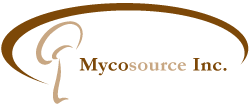This King Oyster mushroom kit consists of hardwood chips/sawdust, organic wheat bran and a small quantity of agricultural gypsum. It is totally free of chemicals and additives. It is probably totally white from the mycelium which has grown through the chips/sawdust mix. This mycelium is the fungus organism; with the proper care and stimuli it will produce “fruits” or mushrooms. The kit includes a perforated plastic bag and bamboo skewers which will be used to set the kit up for production.
To provide the stimuli necessary for mushroom “fruiting” follow these steps:
- Leave the kit in its original bag, undisturbed, at room temperature, for 2 to 3 days to recover from shipping. With a sharp knife cut the top of the bag off, leaving 2″ (5 cm) above the block. Add water to the casing soil that comes with the kit so that it is moist but not dripping. Spread it evenly over the exposed top part of the block. The plastic bag remaining above the edge of the block will hold it in place.
- This kit must be kept in a high-humidity environment (85-95% RH). This can be achieved by using the perforated bag and the wooden skewers as per the drawing. Insert the skewers into the block in an arrangement that will hold the perforated bag in a tent-like position over the block. The skewers should be inserted about 1-2 inches into the block, two on the top pointing up and 4 around the top perimeter at a slight angle up. Drape the supplied perforated plastic bag over the skewered block so that it forms a tent-like structure over the block. It is important to arrange the skewers so that the bag does not touch the block.
In order to maintain high humidity, mist the casing soil and the interior
of the “tent” with water a couple of times per day. Do not make the casing too wet. Place the kit on a tray or pie plate large enough to protect the surface of the table or floor because water will condense on the inside of the bag and drip down. Please note that the block of mycelium is alive and needs to “breathe”; the perforations in the bag will allow an exchange of gases. Mushrooms require some light, but not direct sunlight as it is too strong. A shady corner, or a florescent light will be adequate. The optimum temperature range for the kit is 18-25°C (65-80°F). - Small “bumps” should start to push through the casing layer in 1-2 weeks. Once the mushrooms start to form they should not be wet or they will rot. At this point it is advisable to direct the mist around the inside of the bag or rather than directly onto the mushrooms. This will facilitate a high humidity environment while avoiding wet/soaked mushrooms. Continue with this misting procedure until the mushrooms are ready to pick.
- Keep the kit in the tent. Continue the misting procedure and keep the casing soil damp but not drenched. The mycelium will digest more wood lignin and build up energy for the next “flush”.
- After the kit is depleted you can break it up. It makes an excellent soil conditioner and can be added to your potted plants or garden.
* Check your kit regularly for green mold. If you notice an increasing amount of green mold on the casing soil, moderate the spraying regime as the micro-environment may be too humid. If mold has overgrown the kit you can remove some of the casing soil and you can sprinkle some baking soda on the top to keep the mold in check.
These mushrooms produce a long stem and smaller cap than regular oyster. All of the stem except a bit at the bottom is edible. The mushrooms have an excellent texture and delicate flavor.
When frying the mushrooms it is advised to cover the frying pan and/or adding some liquid towards the end of the frying to “steam” the mushrooms.
